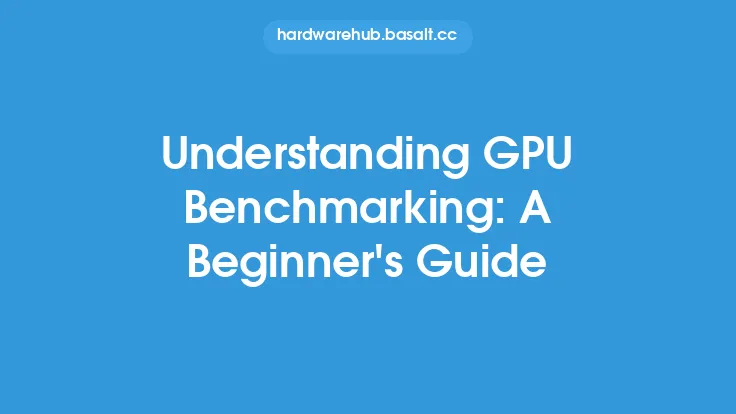Getting started with understanding GPU architecture can seem like a daunting task, especially for those who are new to the world of computer graphics and parallel processing. However, having a solid grasp of the fundamentals is essential for appreciating the intricacies of modern graphics processing units (GPUs). In this article, we will delve into the basics of GPU architecture, exploring the key components, their functions, and how they work together to enable the stunning visuals and rapid computations that GPUs are known for.
Introduction to GPU Components
At the heart of every GPU lies a complex array of components, each designed to perform specific tasks. The primary components include the graphics processing clusters (GPCs), texture mapping units (TMUs), render outputs (ROPs), and the memory interface. GPCs are the main processing units of the GPU, containing the CUDA cores (in NVIDIA GPUs) or stream processors (in AMD GPUs), which are responsible for executing the majority of the graphical and computational tasks. TMUs handle texture mapping, which involves applying textures to 3D models, while ROPs are responsible for the final rendering of pixels on the screen. The memory interface, including the video random access memory (VRAM), facilitates data transfer between the GPU and the system memory.
GPU Processing Clusters
GPU processing clusters, or GPCs, are the fundamental building blocks of a GPU's processing power. Each GPC contains several streaming multiprocessors (SMs) in NVIDIA GPUs or compute units (CUs) in AMD GPUs. These SMs/CUs are further divided into smaller execution units, known as CUDA cores or stream processors, which are the actual processors that perform calculations. The number of CUDA cores/stream processors within a GPU determines its raw processing power, with more cores generally leading to better performance in games and applications that utilize GPU acceleration.
Memory Hierarchy
The memory hierarchy of a GPU is designed to optimize data access and minimize latency. At the top of the hierarchy is the register file, which provides the fastest access to data but has limited capacity. Below the register file lies the shared memory, which is a small, on-chip memory space that is shared among threads within a block. The L1 and L2 caches come next, providing a buffer between the shared memory and the off-chip VRAM. VRAM serves as the main memory for the GPU, storing textures, frame buffers, and other data. The memory interface, including the memory controllers and the memory bus, manages data transfer between the GPU and system memory.
Instruction Set Architecture
The instruction set architecture (ISA) of a GPU defines the set of instructions that the GPU's processing units can execute. Modern GPUs support a variety of ISAs, including CUDA for NVIDIA GPUs and OpenCL for both NVIDIA and AMD GPUs. These ISAs provide a set of instructions for tasks such as floating-point operations, integer operations, and memory access, allowing developers to write programs that can be executed directly on the GPU. The ISA is a critical component of GPU architecture, as it determines the types of operations that the GPU can perform and how efficiently it can perform them.
Parallel Processing
One of the key advantages of GPU architecture is its ability to perform parallel processing. By dividing tasks into smaller, independent threads, GPUs can execute thousands of threads concurrently, achieving significant performance gains over traditional central processing units (CPUs). This parallelism is made possible by the massively parallel architecture of modern GPUs, which can contain thousands of processing units. The ability to handle parallel workloads efficiently makes GPUs particularly well-suited for tasks such as scientific simulations, data analytics, and machine learning, in addition to graphics rendering.
Power Management
As GPUs have become more powerful, power management has become an increasingly important aspect of their design. Modern GPUs incorporate a variety of power-saving techniques, including dynamic voltage and frequency scaling, power gating, and clock gating. These techniques allow the GPU to adjust its power consumption based on workload, reducing heat generation and increasing battery life in mobile devices. Additionally, many modern GPUs support variable rate shading and other technologies that can reduce power consumption during graphics rendering.
Conclusion
Understanding GPU architecture is crucial for appreciating the capabilities and limitations of modern graphics processing units. From the processing clusters and memory hierarchy to the instruction set architecture and parallel processing capabilities, each component plays a vital role in enabling the rapid computations and stunning visuals that GPUs are known for. As GPUs continue to evolve and improve, their architectures will likely become even more complex and sophisticated, supporting new technologies and applications that we can only begin to imagine. Whether you're a developer looking to leverage the power of GPUs for your next project or simply a tech enthusiast interested in learning more about these incredible devices, having a solid grasp of GPU architecture is essential for unlocking their full potential.





